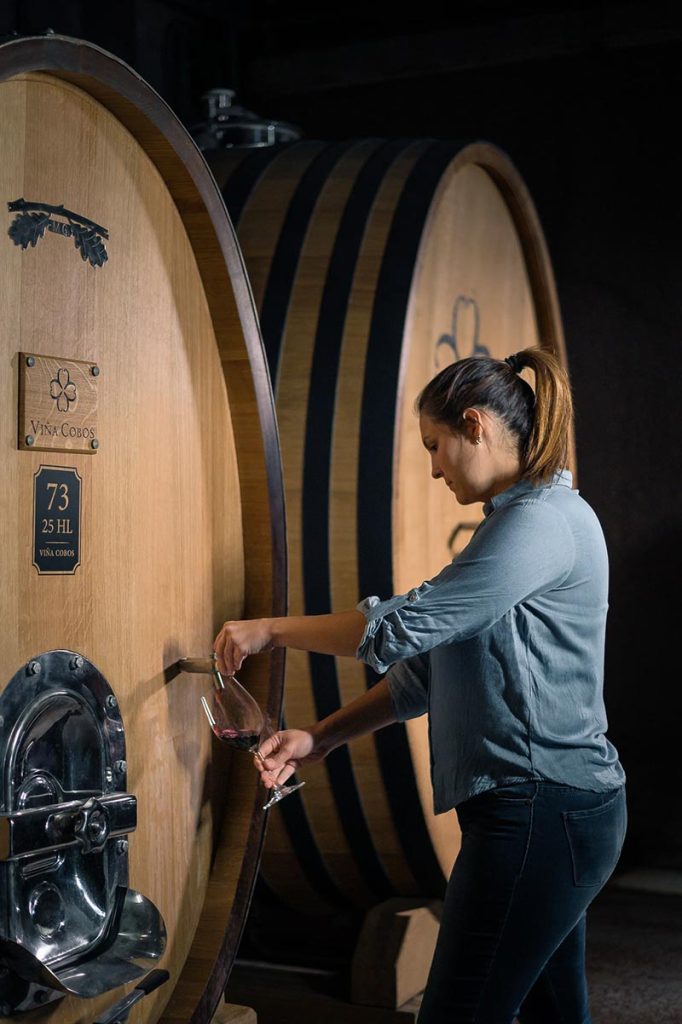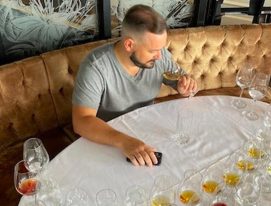In 2013, shortly before earning her oenological degree at the Don Bosco Faculty of the Universidad Católica de Mendoza, Diana Fornasero’s job application impressed at Viña Cobos, the Mendoza winery run by the renowned American oenologist Paul Hobbs which pioneered the production of high-end wines in Argentina.
She began her professional career there, working in every stage of the production chain, and a decade on she has been named the house’s oenological director from the 2022 harvest onward.
Diana Fornasero talks to us about her varied experiences, the international challenges for Malbec today and how to keep up with the global elite.

Interview with Diana Fornasero
How does your experience of the entire production process affect your oenological work?
I think it allows me to provide detailed guidance and suggestions about how to do things, which is what I have been taught since I arrived at Viña Cobos. It’s an approach that helps us to achieve continuous quality and improvement because learning to do every task, such as washing out a tank, for example, gives you an idea of how long it takes and the demands involved.
I wasn’t just involved in the production, harvest, aging and bottling departments, I also worked in the quality control department on the labels, corks, and bottles, and in the laboratory, interpreting the analyses of the wine. I think that this experience validates my decision-making because I didn’t just start out in management. All that experience helps me to have a complete vision and choose the right paths to take.
How did the different jobs at the winery affect your overall vision?
When I got to Viña Cobos my head was full of what I’d learned at school and I soon found that much of that is never put into practice in the real world. That was when I started to learn about oenology from another perspective, taking as natural an approach as possible.
I had been schooled in a traditional, old-fashioned paradigm and little by little I absorbed the rising new trends: conserving the terroir in the best possible way and to have that come out in the wines.
In that regard, Paul Hobbs has been very important because he’s more than just a consultant, he’s one of the owners and has the final word.
Diana Fornasero, can you describe your creative relationship with Paul Hobbs?
We are engaged in a dynamic, ongoing conversation. Paul isn’t the typical boss who gives orders, he’s very open to new ideas and suggested changes. He comes to Argentina several times a year and we make our decisions about wine blends together.
It’s teamwork: I give the team three or four options within the same conceptual framework but with varied profiles and we taste them together with the second oenologist Nicolás Antich, Marina Miceli Di Pietro and Pablo Debernardi (the agricultural team), and the commercial director. Then we rank our favorites and make our choices.
We keep tasting the product throughout the process. Paul comes during the harvest season to determine the harvest time and we taste the wines from last year that haven’t been bottled yet and the ones still in the barrel to see how they’re developing. We’re continuously tasting and making assessments.
Viña Cobos has two clearly defined, distinctive profiles: Uco Valley and Luján de Cuyo. What is your approach to each?
The portfolio begins with Felino, a varietal from different areas of Luján de Cuyo and the Uco Valley. Then comes Cocodrilo, another blend but with the regions less clearly defined.
For the Bramare Appellation line we separate out Luján de Cuyo and the Uco Valley. We have 50 hectares that belong to the winery while we buy grapes from 300 hectares owned by other like-minded producers, whose work in vineyards is overseen by our agricultural engineers.
Once the grapes are harvested, each vineyard goes separately into its own fermentation tank so that they’re all made in exactly the same way and the same is true of barrels so that the differences between them are clearly due to their respective places of origin.
We work similarly with the Single Vineyards, which all belong to us: Marchiori, Chañares and Zingaretti. Each of them is made separately and is monitored separately in both the vineyard and the winery.

Diana Fornasero’s view of the future of Argentine wine
As international leaders in high end Malbec, what do you think of its international future?
We are confident that the variety still has plenty to offer. In our case, we know that there’s still lots of scope to continue perfecting our work at Viña Cobos thanks to our research at the vineyard – both the terroir and crop management – and our interaction with the Malbec at the winery, whether it’s fermentation processes or barrel choices.
With regard to the latter, we can now work far more precisely than twenty years ago as we’ve been studying the results we get with different kinds of oak, depending on the forest it comes from, the toast and the barrel size. We do this for each vineyard and so — year after year – we perfect our wines to ensure that we remain leading producers of Malbecs from Argentina due to their elegance, concentration and refinement.
And I know that every producer has their own working methods and plans to keep surprising the world with the potential that Malbec has to offer.
Speaking of Argentine wine as a whole, apart from Malbec, what other aspects, wines or varieties are Viña Cobos working on today?
At Viña Cobos, since the winery began, we have been focusing on Cabernet Sauvignon and Chardonnay. Argentina has the potential to become a world leader in these varieties and our wines are demonstrating that we’re on the right path to achieving that.
We’re focused on identifying areas where Cabernet Sauvignon and Chardonnay can achieve the greatest possible expression of the different terroirs of Argentina.
Cabernet Franc has also become another focal point for the winery at our Chañares vineyard in Los Árboles, Uco Valley.
Additionally, I’d also like to mention our work on sustainability over the past few years at the winery and in the vineyards, both the ones we own and those belonging to the producers with whom we work. Regenerative viticulture is one of our priorities.
Viña Cobos Malbec has just started being traded on La Place de Bordeaux, a major achievement for Argentine wine. What challenges come with maintaining your place at the top?
To us, it’s very important to maintain the quality and standards of our work with Cobos Malbec, and to do that we are investing in our vineyards in order to improve our hydric efficiency, soil management and research.
Paul Hobbs is convinced that vineyard management is the most important factor, which is why we keep a detailed eye on each plant. At Viña Cobos the terroir was always a priority and this message has been consistent, just like the quality of each of our wines.


